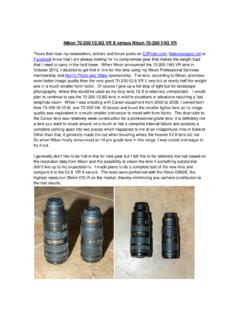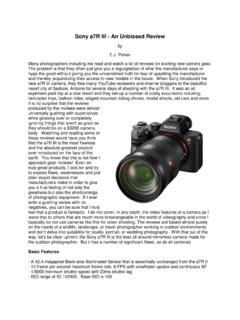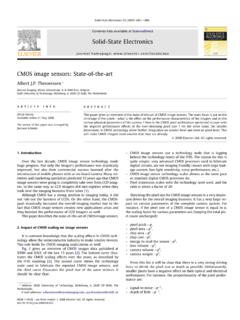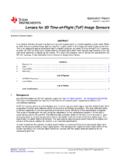Transcription of Medium Format vs 135mm - EJPhoto.com
1 High End 645 Medium Format vs. High End 135 Full Frame Format by Peiker Every time the traditional 36x24mm "full frame" camera world announces a camera with a new sensor , the internet photo forums go wild with claims that Medium Format is now officially dead. Sometimes these claims come from surprising sources that clearly know that their claim is just a headline used to generate clicks on their website and simply not true. In fact, with the recent introductions of new Medium Format cameras at prices that are at least a little more consumer friendly than in the past, Medium Format digital photography is one of the few segments in photography that is actually growing. When I first started dabbling in digital Medium Format a few years ago for landscape photography, I performed a field comparison between a Phase One 645DF+/IQ160 60 megapixel digital back with the original version of the Schneider Kreuznach 75-150mm lens and a Nikon D800E 36 megapixels camera with the Nikkor 24-70mm lens.
2 The 75-150mm offers a field of view that is approximately equal to 48-96mm equivalent on a full frame camera so there was plenty of focal length overlap to do the comparison. I found that the Medium Format option was able to render significantly higher fine detail, especially as you looked farther and farther into the scene. You can find the original article here: While I stand by the results of that comparison, the two lenses used are quite different. Most of the shortcomings of the old mid 1990's Mamiya derived 645DF+ camera described in that article are now a thing of the past. The much more modern Phase One XF camera platform reduces or eliminates many of the Medium Format disadvantages significantly. Cost and weight are of course still a consideration although the Fuji GFX 50 megapixel cropped sensor Medium Format camera has brought system costs to the same neighborhood as the most expensive 135 Format DSLRs like the Nikon D5 and Canon EOS 1Dx Mk II.
3 Autofocus performance, specifically speed of focus acquisition and tracking, is still vastly superior on 135 cameras compared to any Medium Format offering. But Medium Format has modernized itself significantly so I felt that it was time to do the comparison again, this time using the best sensors available in both Medium Format and 135 full frame Format . I have also chosen the finest equivalent field of view lenses targeted at landscape photographers that are available for each system. Here is the hardware that I used for this comparison: 135 Format Challenger: - Sony a7R Mk II with 42 megapixel 36x24mm Back-side illuminated Sony sensor - Zeiss Loxia 21mm Distagon Lens with 91 degree angle of view on 135 Format Medium Format Presumptive Champion: - Phase One XF with IQ3100 101 megapixel 40mm Sony sensor - Schneider Kreuznach 35mm Lens with 89 degree angle of view on digital 645 Medium Format (approximately equivalent to a 22mm lens in 135 terms) The 101 megapixel Phase One back has a sensor area advantage over the a7R Mk II's sensor .
4 The Sony camera's base ISO is 100 and to keep everything the same, I also used ISO 100 on the Phase One system even though its base ISO is 50. It has been shown that the IQ3100 digital back has identical dynamic range and noise performance at ISO 100 and ISO 50 so I have introduced no disadvantage there. Neither sensor employs an anti-aliasing filter so that is not a factor in the tests. Aperture values were compensated to deal with the inherent depth of field difference between a 35mm lens and a 21mm lens. Note that the reason for two significantly different focal lengths that yield equivalent angle of views on the two different formats is the large difference in sensor size. This means one uses a longer focal length lens on Medium Format to take what looks like the same picture as one taken with a shorter focal length on full frame 135 Format . The depth of field, if apertures are kept identical, due to this focal length difference is less on Medium Format .
5 While it is impossible to perfectly eliminate this due to needing 1/6 stop aperture granularity for that, shooting the 35mm Medium Format lens at f/8 and the 135 Format lens at essentially eliminates DOF differences while shooting both lenses approximately 2 stops from their maximum aperture. This puts both lenses within the best image quality aperture range for the lens. The Sony system does not require focus calibration since it focuses at the sensor level and the Zeiss 21mm lens is manual focus. The Phase One focusing system is located off sensor so a careful lens calibration (Focus Trim in Phase One language) was performed with Phase One's new automated lens calibration. Focus was carefully checked in magnified Live View prior to exposure to insure that focus did not play a role in any resolution/sharpness comparisons. An extremely sturdy Gitzo 4 series tripod with spikes was used in calm wind conditions and the images were taken with a 5 second delay between tripping the shutter and the actual exposure.
6 Both cameras were set for electronic first curtain and focal plane shutter second curtain. The Phase One camera was shot with the mirror locked up since the Sony has no mirror. Both were shot in a lossless RAW Format , the Sony at its maximum 14bit per color RAW mode and the Phase One at its maximum 16 bit per color RAW mode. Capture One was used to process the images. This is the recommended RAW processor by Phase One and Sony for these respective cameras - both cameras ship with a link to download Capture One and it has very specific camera profiles internal to the software for each camera. I usually rely heavily on resolution test charts but both set-ups easily outresolve the 4000 lines per frame resolution of the ISO 12233 resolution test chart so I resorted to a real world landscape photography scene with a decent dynamic range and lots of detail in the distance. Below you will find the two images used for the comparison, without any adjustments from the Capture One defaults for that camera and lens.
7 These are straight from the camera into Capture One and then converted to TIFF and loaded in Photoshop where no adjustments of any kind were made keeping everything completely equal: The top photo is from the Phase One in its native 4:3 aspect ratio and the second is from the Sony in its native 3:2 aspect ratio. One can see that vertically the two images are nearly identical in their field of view and horizontally the 21mm lens on the a7R Mk II is a bit wider than the 35mm lens on the Phase One due to the aspect ratio difference between the two sensors. Careful examination also reveals slightly more contrast in the Sony image than the Phase One photograph - we will see later why that is the case. My careful white balance calibration of each camera paid off as the two have virtually identical color temperatures. Next we will look at fine detail rendering. In recent years, as the megapixel count has come up on 135 Format cameras, there is the inevitable discussion that Medium Format is obsolete and no longer offers image quality benefits.
8 Let's see if that's true: These are 100% pixel view samples of identical areas from each camera - the difference in size is due to the difference in sensor size and the number of pixels that each sensor in rendering an equivalent part of the scene. To keep things consistent, throughout this article the Phase One files are always displayed first and the Sony files second. In this comparison you can see significantly more detail in the XF-IQ3100 sample than you can in the a7R Mk II sample. Note that these samples represent a mere of the total pixels in the photograph. To equalize the sizes, as we would if we were printing the two at the same size, we will first look at the results of uprezzing the 42 megapixel Sony a7R Mk II files to match the 101 megapixel Phase One files: The difference between the crop of the 101 megapixel image on the left and the same crop and then uprezzed on the right are dramatic. Individual blades of grass, even at this extreme crop as well as fine details on the Mesquite Tree are clearly rendered on the left and are very soft on the right.
9 Clearly there is a very significant advantage to the 101 megapixel digital back over the 42 megapixel mirrorless camera. This would be plainly visible in larger prints Many people do not print larger than 13x19, the largest size supported by most quality desktop photo printers. So let's see what would happen if we downrezzed the Phase One file to the same size as the Sony file as one would when making these smaller prints: The Sony file on the right clearly looks much better in its native resolution than when uprezzed but downrezzing the Phase One 101 megapixel file, there is still significantly more detail leading to more detail in the final print. This analysis shows that the claim that modern high megapixel full frame 135 Format cameras render scenes with as much detail as Medium Format is false. While I don't currently have a 50 megapixel Medium Format back to show a comparison of a larger sensor with similar pixel count, in my experience shooting 50 and 60 megapixel Medium Format , there is still a very visible difference.
10 Today's 135 full frame sensors deliver incredible detail compared to just a few years ago but they are no match for current generation and even one to two generation old Medium Format sensors. The other area that must be compared to paint a clear picture of the differences for landscape photographers between high end Medium Format and high end 135 Format is dynamic range. The pixel size of these two sensors is virtually identical but the Medium Format camera records 16 bits per color compared to 14 bits per color on the a7R Mk II. This gives the Medium Format camera an inherent advantage but this is at least somewhat offset by the a7R Mk II's back-side illuminated (BSI) sensor design. This technology moves interconnects and other circuitry underneath the pixel wells rather than in between them allowing more efficient pixel wells. When first loading the RAW files into Capture One and looking at the histogram of the file, I noticed right away that there was a bit more headroom on the low end in the 101 megapixel file.












